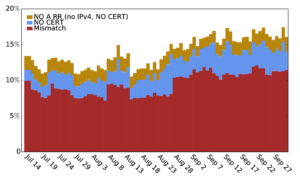Wes Hardaker gave two presentations at DNS-OARC on November 1st, 2019. The first was a presentation about the previously announced “Cache me if you can” paper, which is on youtube, and the slides are available as well. The second talk presented Haoyu Jiang’s work during the summer of 2018 on analyzing DNS B-Root traffic during the 2018 DITL data for levels of traffic sent by the Chrome web browser, levels of traffic associated with different languages, and levels of traffic sent by different label lengths. It is available on youtube with the slides here.
Tag: DNS-OARC
John Heidemann gave the talk “Anycast Latency: How Many Sites are Enough?” at DNS-OARC in Dallas, Texas, USA on October 16, 2016. Slides are available at http://www.isi.edu/~johnh/PAPERS/Heidemann16b.pdf.
![Comparing actual (obtained) anycast latency against optimal possible anycast latency, for 4 different anycast deployments (each a Root Letter). From the talk [Heidemann16b], based on data from [Moura16b].](https://ant.isi.edu/blog/wp-content/uploads/2016/10/Heidemann16b_icon-300x212.png)
This talk will evaluate anycast latency. An anycast service uses multiple sites to provide high availability, capacity and redundancy, with BGP routing associating users to nearby anycast sites. Routing defines the catchment of the users that each site serves. Although prior work has studied how users associate with anycast services informally, in this paper we examine the key question how many anycast sites are needed to provide good latency, and the worst case latencies that specific deployments see. To answer this question, we must first define the optimal performance that is possible, then explore how routing, specific anycast policies, and site location affect performance. We develop a new method capable of determining optimal performance and use it to study four real-world anycast services operated by different organizations: C-, F-, K-, and L-Root, each part of the Root DNS service. We measure their performance from more than worldwide vantage points (VPs) in RIPE Atlas. (Given the VPs uneven geographic distribution, we evaluate and control for potential bias.) Key results of our study are to show that a few sites can provide performance nearly as good as many, and that geographic location and good connectivity have a far stronger effect on latency than having many nodes. We show how often users see the closest anycast site, and how strongly routing policy affects site selection.
This talk is based on the work in the technical report “Anycast Latency: How Many Sites Are Enough?” (ISI-TR-2016-708), by Ricardo de O. Schmidt, John Heidemann, and Jan Harm Kuipers.
Datasets from the paper are available at https://ant.isi.edu/datasets/anycast/
Liang Zhu gave the talk “Measuring DANE TLSA Deployment”, given at the Fall DNS-OARC meeting in Los Angeles, California on Oct 12, 2014. Slides are available: http://www.isi.edu/~liangzhu/presentation/dns-oarc/dane_tlsa_survey.pdf
The DANE (DNS-based Authentication of Named Entities) framework uses DNSSEC to provide a source of trust, and with TLSA it can serve as a root of trust for TLS certificates. This alternative to traditional certificate authorities is important given the risks inherent in trusting hundreds of organizations—risks already demonstrated with multiple compromises. The TLSA protocol was published in 2012, and this talk presents the first systematic study of its deployment. We studied TLSA usage, developing a tool that actively probes all signed zones in .com and .net for TLSA records. We find the TLSA use is early: in our latest measurement, of the 461k signed zones, we find only 701 TLSA names. We characterize how it is being used so far, and find that around 7–12% of TLSA records are invalid. We find 31% of TLSA responses are larger than 1500 Bytes and get IP fragmented.
The work in the talk is by Liang Zhu (USC/ISI), Duane Wessels and Allison Mankin (both of Verisign), and John Heidemann (USC/ISI).
